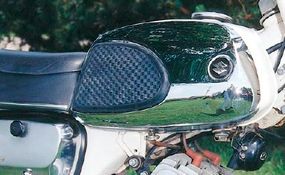Though the 1966 Suzuki T10 motorcycle is representative of modern-day Suzuki's skills at manufacturing motorcycles, Suzuki started out in 1909 building an entirely different sort of machine. Silk production was a major industry in Japan at the time, and the company got its start making silk looms.
Advertisement
Though Suzuki built an experimental engine in the late 1930s with an eye toward production, World War II intervened.
After the war, the company switched to heaters and farm machinery, and it wasn't until 1952 that the engine resurfaced. It came in the form of a small 36-cc two-stroke that could be fitted to a bicycle, and Suzuki was on the road.
Production of a complete 90-cc motorbike began in 1954, and Suzuki was one of the first companies to introduce oil injection on its two-strokes. That relieved riders of having to mix the gas and oil themselves.
In 1963, Suzuki built a road-going version of a 250-cc two-stroke twin that had been raced in the 1950s. It called it the Suzuki T10.
Along with oil injection, the Suzuki T10 motorcycle was fitted with such luxuries as electric start, hydraulic rear brake, turn signals (not yet universal), and an enclosed drive chain.
Its pressed-steel frame resulted in flowing contours aft of the chrome-sided fuel tank, and that, along with 17-inch wheels, tire-hugging front fender, and telescopic front forks, gave the Suzuki T10 motorcycle a contemporary look.
Performance was not a priority, the Suzuki T10 motorcycle being aimed at commuters with its mild-mannered engine boasting a broad torque range. That philosophy, however, was about to change.
Keep reading for more pictures about the 1966 Suzuki T10 motorcycle.
For more great motorcycle articles and pictures, check out:
- Classic Motorcycles
- How Motorcycles Work
- Other Classic Motorcycles
Advertisement




